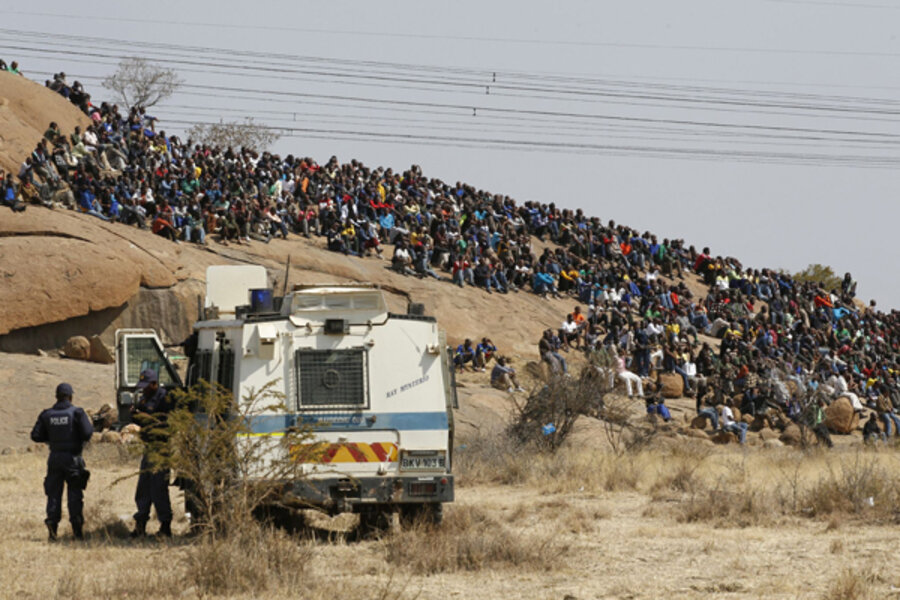One year after South Africa's Marikana massacre: why, what, and how
Loading...
On Aug. 16, 2012, South African police opened fire on a crowd of striking miners at the Lonmin Platinum mine near the town of Marikana, killing 34 and injuring 78 more – the worst single incident of police violence in the country since apartheid security forces massacred 69 protesters near Johannesburg in March 1960.
One year later, the killings at Marikana have not augured well for Africa’s wealthiest nation. The tragedy has left the South African economy battered, revealed new fissures in country’s labor movement, and prompted continuing ripples of unrest in South Africa’s globally important platinum and gold fields.
Here’s what you need to know:
What was the original strike all about?
Six days before the police killings last August, rock drillers at the Lonmin mine went on strike for massive wage increase – from R4,000 ($500) per month to R12,500 ($1,500). Their demand was greeted with an icy reception, not only from Lonmin, but also from the National Union of Mineworkers (NUM), the muscular union that had long negotiated for miners at in the area.
But NUM, the union, hadn’t authorized this strike, which was organized instead by an unrecognized rival union, the Association of Mineworkers and Construction Union (AMCU). For months, AMCU had been building a base of support from among NUM’s discontents, who complained that the powerful union had been corrupted by its cozy relationship to South Africa's political leadership. (NUM is part of the Congress of South African Trade Unions (COSATU), a close ally of the ruling African National Congress. Tellingly, one of the union’s apartheid-era founders, Cyril Ramaphosa, sat on the Lonmin corporation’s board of directors at the time of the killings).
Over several days in August, strikers wielding rocks and machetes sparred with both police and NUM officials, resulting in 10 deaths. As the crisis escalated, media arrived to capture the scene, and on August 16, news cameras were on hand to record footage of police confronting strikers in the scrubby grasslands near the mine, firing indiscriminately into the crowd. Three minutes later, some three dozen people were dead.
What was the reaction?
Immediately following the massacre, President Jacob Zuma called the event “tragic and regrettable” but said it was “not an occasion for blame, finger-pointing or recrimination,” while his Police Chief Riah Phiyega told reporters that “the police members had to employ force to protect themselves from the charging group.” With great fanfare, Mr. Zuma’s government launched a commission of inquiry into the killings and gave it four months to do its work. A year later, it has yet to issue any findings or launch any prosecutions – in part because many victims and their families cannot afford legal counsel, and the state has refused to provide it.
Meanwhile, the violent confrontation touched a raw nerve among workers in many sectors of the South African economy. Wildcat strikes – that is, strikes not led by a recognized union – continued at Lonmin and other gold and platinum mines (as well as farms) throughout the winter and into spring.
Production at many of those mines slowed to a crawl, and because mining accounts for 60 percent of South Africa’s exports, that sent the economy tumbling. Just after the massacre, both Standard & Poor’s and Moody’s downgraded South Africa’s credit rating for the first time since the end of apartheid, and its currency began to backslide. Since August 2012, the Rand has plummeted nearly 15 percent against the dollar.
Why does that matter?
For one thing, we need platinum, and South Africa has 80 percent of the world’s reserves. Platinum’s primary use is in vehicle emissions – it is the core element of a catalytic converter. Lonmin’s South African mines alone produce 12 percent of the world’s output of the rare metal. In the days following the massacre, as they and other mining giants temporarily closed their operations, the global price of platinum spiked.
Since then, the continuing unrest in the country’s mines has sounded global alarm bells. The Eurasia Group, for instance, rated South Africa among the world’s 10 most risky markets for 2013, writing that the volatile economic climate and continuing social unrest had sent the country “headed along a path that gives little reason for optimism.”
How was the original strike resolved?
The strike continued for another month after the massacre, until Lonmin agreed to raises of 11 to 22 percent for most of its workers (depending on their job category). Although the move was widely hailed as a victory at the time, progress quickly stalled. Vicious infighting continued between the two unions in the area – NUM and AMCU – resulting in continued sporadic killings, the most recent of which occurred just last weekend.
Meanwhile, little has changed in the living or working conditions of the workers who instigated the original strikes. They live in sprawling shack settlements near the mines, rife with crime, and have little job security. For them, as for South Africa more generally, the labor disputes of the last year have yet to coalesce into any larger movement. Instead, the unrest shuffles on, awaiting resolution or crisis, whichever comes first.








